Wood Bison Restoration in Alaska
Status of the Herd Updates
Contents
- Wood Bison News
- 2023 Wood Bison Update
- 2022 Wood Bison Update
- 2021 Wood Bison Update
- 2020 Wood Bison Update
- 2019 Wood Bison Update
- 2018 Wood Bison Update
- 2017 Wood Bison Update
- Wood Bison Thrive in 2016
- Wandering Bison
Wood Bison News
- Wood Bison News 2023 (PDF 3,049 kB)
- Wood Bison News 2018 (PDF 4,672 kB)
- Wood Bison News 2015 (PDF 1,006 kB)
- Wood Bison News 2014 (PDF 779 kB)
- Wood Bison News 2013 (PDF 239 kB)
- Wood Bison News 2011 (PDF 859 kB)
- Wood Bison News 2010 (PDF 567 kB)
- Wood Bison News 2008-2009 (PDF 2,657 kB)
- Wood Bison News 2007-2008 (PDF 686 kB)
- Wood Bison News 2005-2006 (PDF 809 kB)
Wood Bison Update Summer 2023
Lower Innoko and Yukon Rivers Herd population survey 2023
The 2022-2023 winter was exceptionally difficult for the Lower Innoko and Yukon Rivers herd, which experienced a significant decline in number. A minimum population count was completed on August 23rd with a total of 72 bison, including 3 calves born this summer and 3 of the bison that were released as yearlings last year. ADF&G and USFWS staff flying the survey found 10 groups of bison, from single bulls up to a group of 57 individuals. Biologists think it was likely that there were a few more bison in the area than the minimum count detected in the survey.
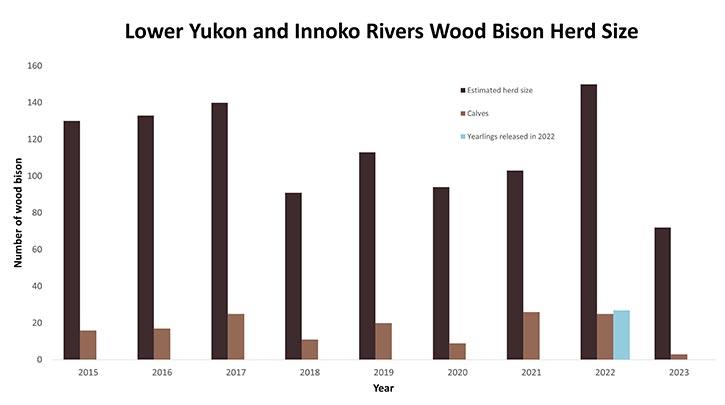
2023 in context
This experimental population was placed in the lower Innoko-Yukon area in 2015 to begin restoration of a native species to Alaska in a part of their original range with vast grassland habitats and abundant support from local people. It was known from the start that occasional late winter deep snows and regional flooding could negatively impact the bison, but it was unknown to what degree. Two releases totaling 158 bison have occurred to establish this experimental herd, 130 in 2015 and 28 in 2022. The herd has persisted since release but has not shown the level of population growth that would be expected from a herd with a prosperous future. However, the future of this herd is still unknown and only time will tell if they will be able to survive in this part of Alaska.
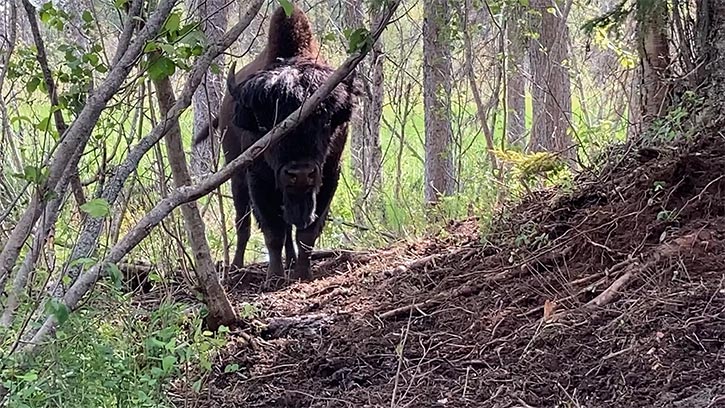
What characteristics of this winter led to the mortality?
The primary factor attributed to the heightened mortality among bison during the winter of 2022-2023 was the prolonged presence of snow conditions that hindered bison from accessing food all winter. Winter set in early, with deep snow in October. Then, a temporary warm spell resulted in the melting and subsequent refreezing of this snow, creating a formidable layer of hardened ice and snow that made it challenging for the bison to reach their forage.
To compound the issue, additional heavy snowfall occurred on top of this already hardened layer, persisting well beyond the usual time of snow melt. Notably, McGrath reported a record 44 inches of snow on the ground on April 15, 2023, and snow was still evident along the Innoko River until late May. These conditions were like those seen during the previous years of decline in 2018 and 2020, although those instances were shorter in duration.
As with other ungulates, bison accumulate body reserves during the summer, which gradually sustain them throughout the winter months. The consumption of forage during the winter helps to slow the depletion of these vital body reserves. However, young bison, with fewer reserves to draw from, experienced a higher mortality rate. Among the adult population, some individuals perished, while others became weakened. These weakened bison became more susceptible to a range of survival-threatening factors, including predation, accidents such as falling through ice or drowning while navigating flooded areas, becoming trapped in deep mud, and complications during the calving season.
The spring of 2023 saw considerable flooding, potentially contributing to the mortality of newborn calves. While biologists observed instances of wolf predation on two bison during the winter, they do not consider predation to be a significant contributing factor to the overall loss of bison during the 2022-2023 winter season.
Were other species affected?
The last few winters in Alaska's interior have been difficult for ungulates. Caribou and sheep populations across the state have seen precipitous declines and moose and bison have declined in many areas.
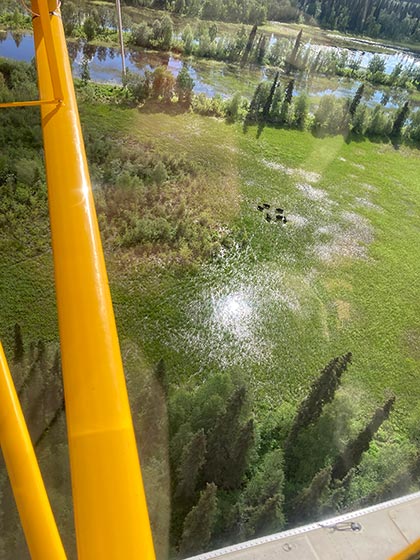
Captive population of wood bison in Alaska
Currently, there are 42 wood bison in captivity at the Alaska Wildlife Conservation Center (AWCC) and 10 at the UAF Large Animal Research Station (LARS). Most bison at both facilities are eligible for release.
What's next?
Biologists will continue to monitor the Lower Innoko and Yukon rivers herd. The Lower Innoko and Yukon rivers wood bison planning team, composed of representatives from 28 different interest groups, will meet in October to discuss the management of this population. The planning team is composed of local communities, regional population centers, landowners, Alaska native interests, wildlife conservation interests, industry, and state and federal agencies.
While good habitat and snow conditions are important aspects to consider for the next release site, public support is also important. ADF&G and the state of Alaska have received several written and verbal communications asking for wood bison restoration efforts to occur in parts of the eastern interior. With the knowledge that bison have the potential to be productive in eastern Alaska and that there is significant interest from the public, ADF&G will continue investigating the potential of release in three areas: the Lower Tanana drainage, the Upper Tanana drainage, and the Yukon Flats. Lower snow levels and softer snow make the eastern interior more conducive to bison productivity, as access to winter forage is likely to be more consistent.
Wood Bison Update Summer 2022
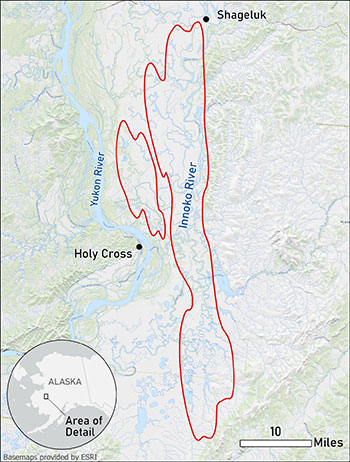
Wild wood bison in the winter of 2021-2022
Eight wild wood bison were radio collared in February of 2022, which allowed biologists to fully assess the winter body condition of wood bison in the Lower Innoko and Yukon Rivers wild herd. In general, the wood bison were extremely fat and in excellent body condition. There was also a notably high survival of calves (26 of 26 still alive) from June of 2021 to February of 2022. 100% survival among any population of young-of-the-year wild animals in Alaska from birth to mid-winter is uncommon.
That the wild wood bison were in excellent body condition was notable, because the winter of 2021-2022 was difficult for many wild animals in interior Alaska. Some localized populations of moose, caribou, and sheep declined as much as 40%. Much of this was due to the deep snow with a 1-1.5" ice layer within it, which impeded animals from moving or gaining access to many of their foods, which was trapped beneath the ice. Severe rain-on-snow events are more common in Western Alaska than the Eastern Interior and are thought to have contributed to the low moose densities in western Alaska over the last 50 years.
However, the weather system that hit Interior Alaska in December of 2021 yielded different results along the Innoko. Instead of the brief rain and deep snow that much of the eastern interior experienced, temperatures were around 40 degrees with rain for a week. This melted most of the existing snowpack. The Innoko area was covered by only soft snow through the rest of the winter, providing easy access to food for bison.
Ice layers and a deep snowpack were present the only years of decline for the herd, 2018 and 2020. These years may indicate that the most significant source of mortality for bison in Alaska is persistent ice layers that prevent bison from accessing foods. Bison seem to handle cold and deep snow well if they can access forage throughout the winter.
Import and release of yearling bison
ADF&G imported 40 yearling wood bison from Canada in April of 2022. 28 yearling bison were eventually transported to the Innoko and released into the wild. ADF&G has an agreement with the Canadian government to get any surplus wood bison calves available in even years to come (2024, 2026, and 2028).
The imported bison calves lived at the Robert G. White Large Animal Research Station (LARS) from April to July when they were transported by truck and barge to the Innoko river. The now yearling bison were unloaded into a soft release pen for two weeks, awaiting connection with the wild herd through the temporary fencing. In early August the yearlings were released and during the following two weeks connected well with the wild herd. It was a challenge to connect 28 captive bison with a herd of wild bison occupying 1500 square miles of roadless wilderness, but with intensive planning, a lot of hard work, and a bit of luck it was a success - radio collar data indicates that the yearlings have remained with the herd.
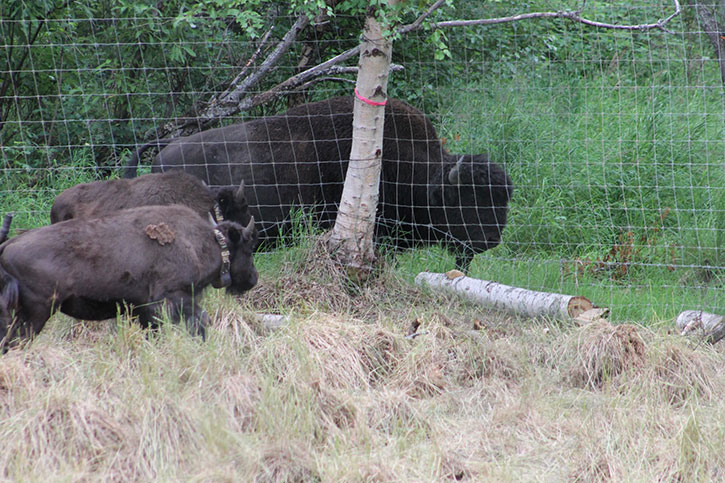
Photocensus population survey of 2022
The population survey of the herd was late this year, it usually occurs in late June. A variety of logistical challenges delayed the photocensus survey until November 28th. ADF&G staff flying the survey found 19 groups of bison, from single bulls up to groups of 52 individuals, during a one-day window of good weather. There were many groups of bison with a large range of group sizes, and search time was limited by short daylight hours. Biologists think it is likely that there were likely a few more bison in the area than the minimum count detected in the survey.
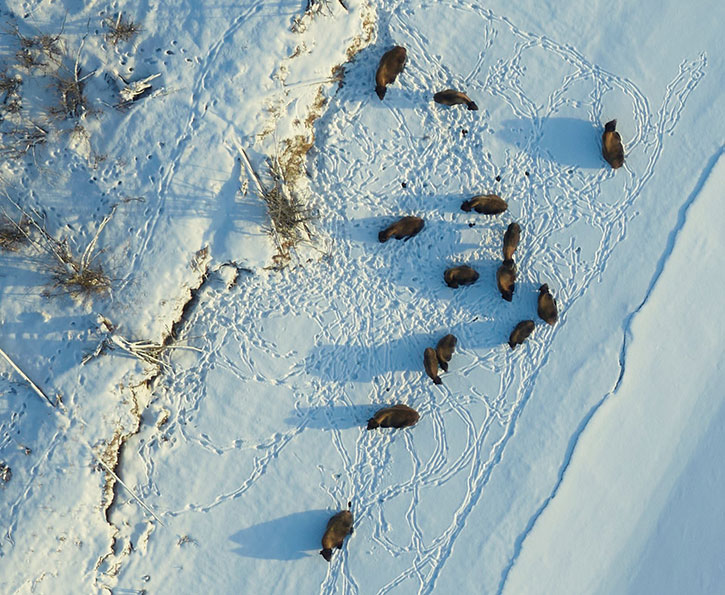
With the addition of 28 captive yearling bison from Canada in late summer, and strong natural growth, the wild herd went from a minimum count of 103 bison in June of 2021 up to a minimum count of 150 in November of 2022. 25 of 26 calves born in the summer of 2021 were located, now roughly 17 months old, and 25 calves were located that were born in the summer of 2022. At the time of the survey, the Lower Innoko and Yukon rivers herd was around 51% calves and yearlings, which indicates that the herd has high potential for future growth. Large cohorts of young animals are the first step required for a growth spurt in wild populations of ungulates. The herd has already been growing for two years. If this large young cohort survives to reproductive age (3 to 20 years), it will mean an additional increase in young cows producing calves, fueling a higher growth rate for the herd.
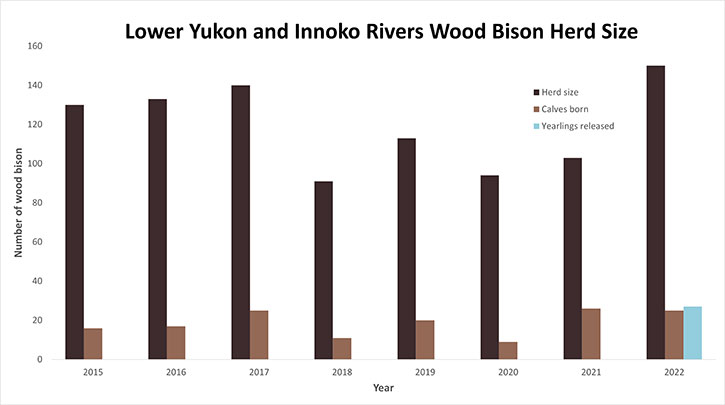
Captive population of wood bison in Alaska
The yearlings from Canada that were not released were added to the captive population of wood bison in the state, in preparation for future releases. Currently, there are 35 wood bison in captivity at the Alaska Wildlife Conservation Center (AWCC) and 10 at LARS. Most of the animals in both facilities are eligible for release and could either augment the herd in the Innoko or help to establish new herds.
2023 and beyond
Biologists will continue to monitor the growth of the Lower Innoko and Yukon rivers herd. The Lower Innoko and Yukon rivers wood bison planning team, composed of representatives from 28 different interest groups, met in 2022 and agreed on a new management plan that will be in effect from 2023 - 2028. The plan is currently moving through final review and revisions before taking effect this year.
While good habitat and snow conditions are important aspects to consider for the next release site, public support is just as important. ADF&G and the state of Alaska have received several written and verbal communications asking for wood bison restoration efforts to occur in parts of the eastern interior. With the knowledge that bison have the potential to be productive in eastern Alaska and that there is significant interest from the public, ADF&G is hosting 3 large public planning team meetings from January to March of 2023 that includes the Lower Tanana drainage, the Upper Tanana drainage, and the Yukon Flats.
For a more detailed summary of wood bison restoration efforts in 2022: Alaska Fish and Wildlife News, February 2023
Wood Bison Update Summer 2021
Biologists completed the annual wood bison photocensus survey on June 23rd, 2021. There was an all-time high of 26 calves with the herd this year. Overall, the herd has grown by more than 10% since the 2020 photocensus to a total of 103 bison, making this a productive year for the herd. Since the release of the Lower Innoko-Yukon Rivers herd in 2015, it has grown in four out of six years. The two years of decline are likely attributed to ice layers forming in the snowpack from winter rainstorms and warming events. Bison are adept at foraging and surviving in deep, soft snow. Wood bison access their food in winter by sweeping the snow aside with their massive heads. Ice layers within the snowpack make this process more difficult. In late winter 2021, there was deep snow, but no ice layers. With any luck, we will not have rain-on-snow events in the coming years and this herd will have a chance to grow to a larger number.
The lower Yukon-Innoko herd is among the bison herds photographed this year by the ultra-high-definition digital camera mounted in the ADF&G de Havilland Beaver for photocensus surveys. This is the same system used for the caribou photocensus.
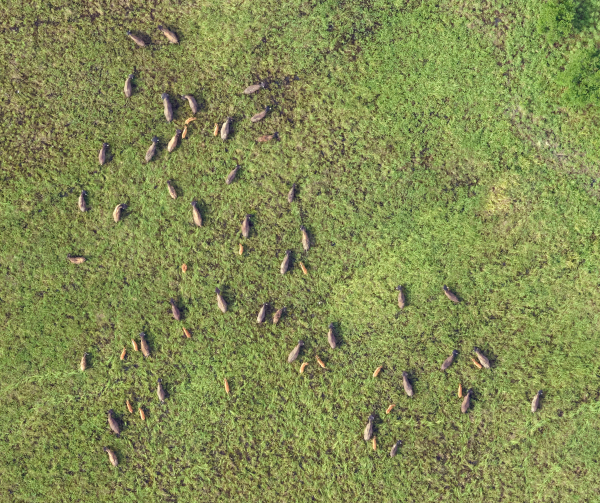
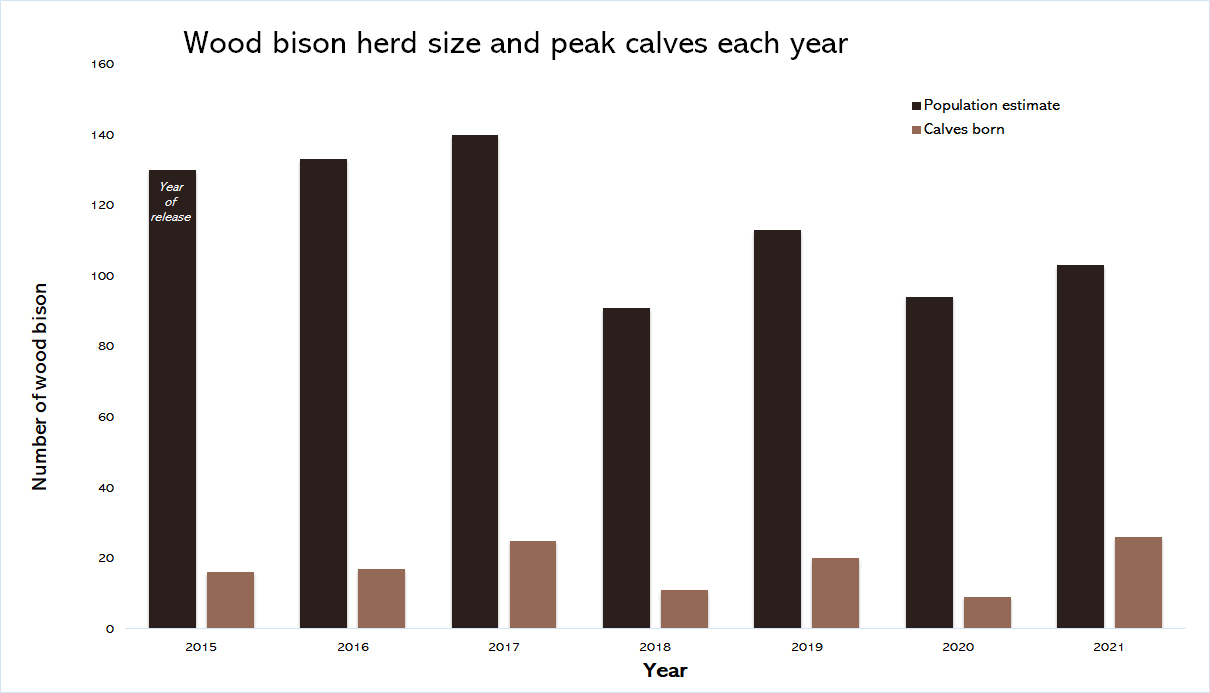
Wood Bison Update, Fall 2020
The winter of 2019-2020 was a difficult one with deep snow and cold temperatures. The wood bison in the lower Innoko-Yukon rivers herd fared well for most of the winter. However, when deep snow persisted through most of the April calving season, there was some mortality.
The logistical challenges presented by the novel corona virus and generally rainy, foggy weather in June of 2020 made surveys difficult, but a survey was finally completed on June 30th. During the survey, bison were not grouped as tightly as we hoped, and some were in the trees making them difficult to see. The survey resulted in a population estimate of 94 bison including 9 calves. This is a 17% decrease from last year's estimate of 113.
This experimental population was placed in the lower Innoko-Yukon area to begin restoring a native species to Alaska in a place with vast grassland habitats and abundant support from local people. It was known from the start that the occasional, notorious late winter snows of the area could negatively impact the bison, but it was unknown to what degree.
As bad as the spring snow conditions were in 2020, the bison did better than expected. They seem to be adapting to the harsh, late winter snow conditions that they experienced in both 2018 and 2020. Since their release in 2015, these bison have experienced 3 years of growth and 2 years of decline. What is notable this year is that the decline was less dramatic than the one in 2018. Snow conditions, specifically in April, seem to regulate the growth of this population. If there is deep, ice layered snow through April in the grass meadows, the bison tend to decline. If there are open grass meadows from most of April, the bison herd increases.
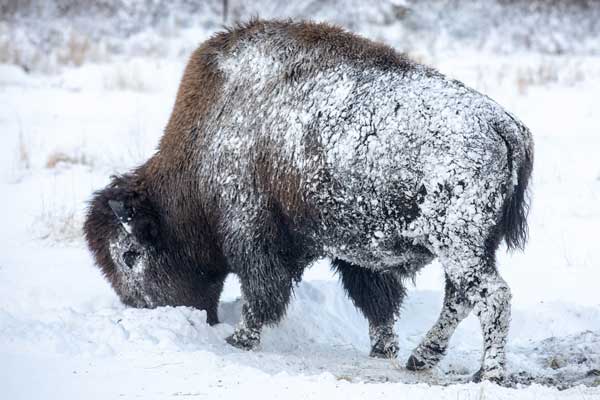
Bison are generalist herbivores, and they adapt to more varied habitats more successfully than most other wild herbivores in North America. Bison have a strong social structure and the young stay with the adult females for at least 3 years. Young female bison often stay with their mother for life. Bison social structure has developed, in part, so that young bison can learn all the nuances of the way the older bison have adapted to succeed in their specific habitat. In this way, the herd adapts its behavior and gets better at surviving in their new home each year.
If you can imagine the release in 2015, none of the bison knew where the best forage and cover were. None of them knew what or where the hazards were going to be, like thin ice, predators, and soft mud. In the 5 short years since release, these bison have learned where the best forage is, what the other hazards are, and how to avoid them. They have experienced difficulties like the April deep snows - each year these bison experience challenges, and they learn how to survive and succeed when that challenge comes their way the next time. This demonstrates the notion of survival and growth through adversity.
At this point, the first wild wood bison population in Alaska in over 100 years has become established and is holding its own, despite facing extremely adverse weather during multiple winters following initial establishment of the herd. With continued adaptation and weather patterns resulting in less late winter snow, this population will continue to learn and grow in the future.
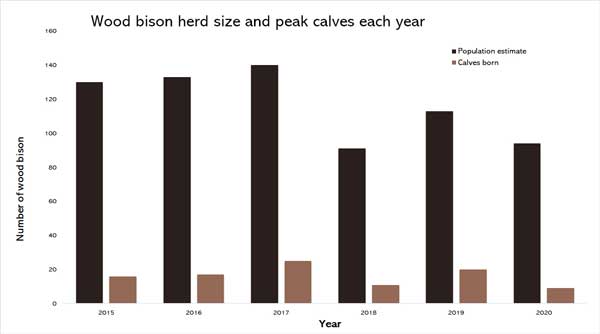
Wood Bison Update, July 2019
Photo census survey
2019 has been a good year so far for the only wild wood bison herd in the United States. The herd was established after a successful release to Western Alaska in 2015. On June 21, 2019 (the summer solstice), a population estimate was completed for the herd which roams in the lower Innoko-Yukon rivers area. Bison were radio-tracked and photographed from department aircraft to get a count, and the results of the photo survey suggest that the herd has rebounded from its low point in May of 2018. The new preliminary population estimate is 113 bison, which includes 20 new calves born this year so far!
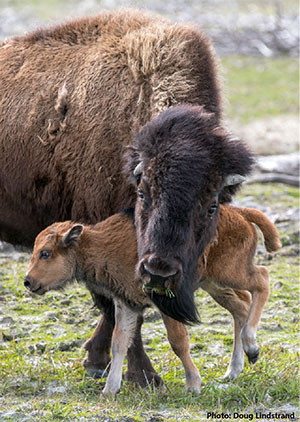
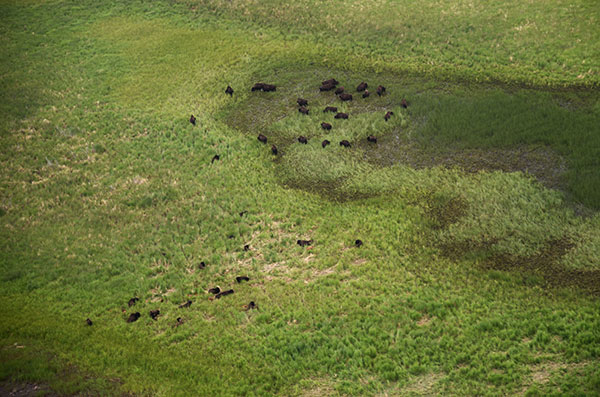
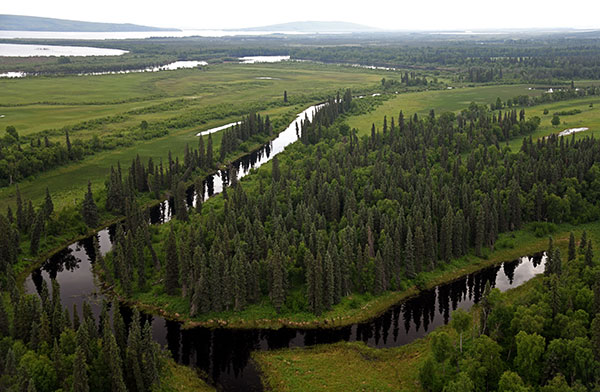
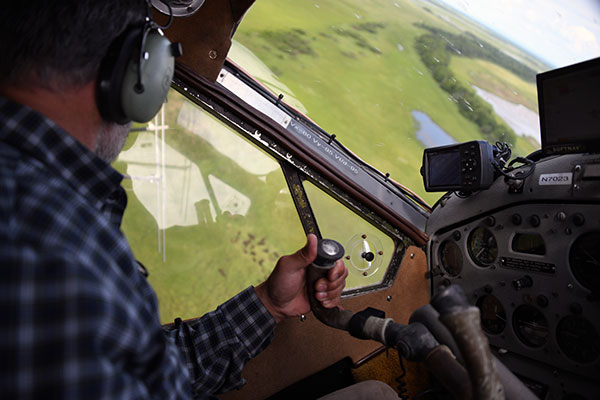
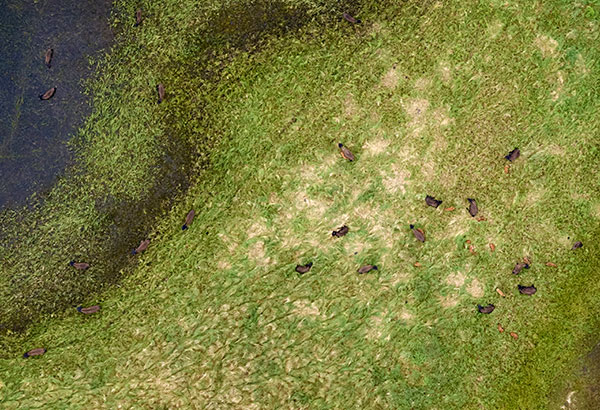
Herd ups and downs
The population decline in the spring of 2018 in the Innoko area was significant. It was caused by snowpack that lasted more than a month longer than usual into the spring, which led to the death of many bison and moose in the area. On the bright side, since the decline last year, the herd population has increased proportionately more than in any other year since the bison were released in 2015. Snow was deep at times in the Innoko this winter, with around 2 feet of powder in January and 3 feet in February. Despite that, there was very little natural mortality and the bison exhibited good body condition throughout the winter. This is evidence that the wood bison are learning from and adjusting to their environment, as the herd approaches 5 years in their wild surroundings. With a bit of luck, the herd will continue to grow and flourish over the next several years. Stay tuned! We expect public planning meetings to begin this winter to discuss the potential release of new groups of bison.
Herd size and peak calves each year
This graph shows the population of the herd since the animals were released into the wild. Each year shows the population estimate derived from the yearly survey, and the number of calves born each year. The harsh winter of 2017/2018 is evident, but it is also clear that 2019 is the strongest year of growth proportionate to herd size since the animals were released into the wild.
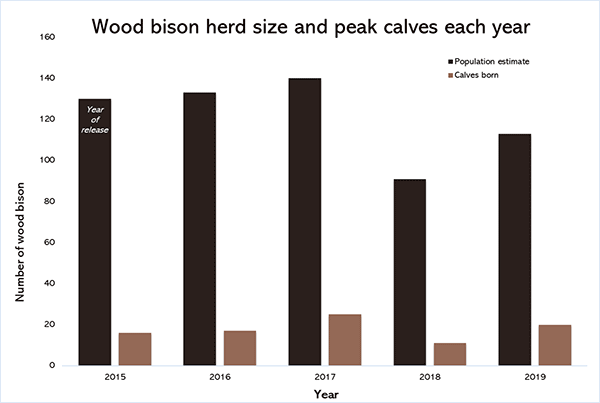
Wood Bison Update, July 2018
A late spring takes a toll on wood bison and other species
Alaska's only wild wood bison herd had significant losses in March and April of 2018, however, the difficult time is over and the bison are again gaining weight and raising new calves. Wood Bison have decreased from an estimated 140 animals in June of 2017 to an estimated 91 animals after June of 2018. The losses occurred during a late winter stress event mostly attributed to difficult snow conditions and an extended winter season.
Bison, as all other large herbivores in Alaska, gain weight in the 4–5 month summertime and then most often lose the weight over the 7–8 month-long winter. Even though winter forage is of relatively low quality, it helps moderate the rate of decrease of their body reserves. Bison also moderate their winter decline in body reserves by limiting their movement and finding shelter from severe weather. Each animal must make it through winter before they run out of body reserves and the vegetation turns green again in the spring. Two of the major factors that cause mortality in large herbivores in Alaska are a late spring and deep snow. With bison, snow texture is specifically important. Bison access their daily food in winter by sweeping snow off the grass and sedge with their head. If the snow is very dense or has hard layers in it, bison may spend more energy and ingest less food, speeding up their decline in body reserves. Entering the winter in 2017, the wood bison were in excellent body condition. Throughout the winter there were few mortalities and it looked like the high winter survival the herd has experienced since initial release would continue. However, in the last week of February it started to snow (and sometimes rain) every few days, and it didn't stop until late April. This set up a deep, firm snow that added a high energy cost for bison to move about and to access forage under the snow. These difficult conditions (high energy output and low energy input) lasted for 2 months, extending the winter when energy conservation is so critical.
Predators took advantage of the snow as well
The difficult snow conditions also added another factor of energy expense — wolves. Wolves had a major advantage during these 2 months because they could run on top of the snow and bison (and moose) had a very difficult time moving. As the weeks went by, the wolves got stronger from eating so well and the herbivores got weaker from the increased harassment by wolves and the lack of access to forage. It is estimated that about ¼ of the bison deaths in spring 2018 were directly from wolf predation. Harassment by wolves most likely contributed to loss of body reserves and subsequent death of others. Wolf predation is not usually a significant factor in healthy bison herds, but these specific snow conditions set up an advantage for the wolves that was so great that wolf predation on this bison herd became significant during late winter 2018.
Wolf predation was not expected to occur this soon. Based on data from Canada's reintroduced wood bison herds, it usually takes decades before wolves start to prey on the bison. It is thought that the snow conditions in spring 2018 turned the tables so much in favor of wolves that predation was initiated much sooner than usual.
As the deep, firm snow and cold winter weather extended into April, calving season started. For some of the pregnant cows that were experiencing steep declines in body reserves with little reserves left, the act of giving birth was just too much additional energy loss and they succumbed.
Green pastures
The wood bison rebounded fast as soon as the vegetation turned green again in May. By mid-June it was hard to see the effects of the late winter as the remaining animals' body condition had recovered so well.
Each trial in life has a positive side. The bison that remain are the bison that can handle a difficult winter event such as this. Most wood bison survived the event, and some even successfully brought off healthy calves (11 new calves as of late June). Future generations of bison in the Innoko area will be built on these 91 wood bison that have the strength and skills to weather this sort of event.
How common is this event? The Innoko river basin is known to sometimes get deep snow, and that was a concern before the wood bison were released. We can look to other species to better understand the uniqueness of this year. Game Management Unit (GMU) 21E moose, GMU 19E moose, and the Farewell plains bison herd (150 miles east) all had the lowest reproduction they've experienced in 20 years this spring. This suggests that winters this difficult are rare.
The future
Wood bison are still learning their range. In the year after the 2015 release, the wild wood bison herd split into a northern and a southern group. The southern group fared much better in this late winter stress event, presumably because they have discovered a local area where we see lower snow depths than surrounding areas. This is an example of how wood bison are still exploring and learning their range. As the years go by, they will get better and better at it. If luck is with them and the weather is in their favor, they will someday grow to a larger population which is much more capable of withstanding catastrophic snow events.
Wood bison are resilient, and this experimental population still has plenty of bison to succeed in establishing a long-term, stable population. Perhaps the natural selection and the experience developed through this tough late winter stress event will help the nation's only wild wood bison herd to thrive. Although we all want to see the wood bison herd increase in number each year, this is not always the path of a new population. We know from other bison herds in Alaska that populations can dip, possibly several times, before growing significantly. But we also know that bison herds in Alaska have been resilient and persistent, and ultimately, successful, and that spring 2018 is just one chapter in a long story for wood bison in Alaska.
Wood Bison Update, 2017
There are several indicators that Alaska's wild wood bison are doing well. Most calves were born early in 2017 (in April), and during a shorter window of time. The peak number of calves (n=25) was reached by June 1. This is a bit earlier than previous years and may indicate that cows were in better body condition in summer 2016 when rut came around, so they conceived earlier. The synchrony of calving may indicate that cows had less variable body condition, meaning that they were consistently in good shape, which would allow for early conception and then efficient gestation.
By late October 2017, 88% of calves had survived their first six months of life. That is better than any of the previous years. It appears that calf numbers and also calf survival are increasing every year.
Despite increased calf input into the population, overall herd growth has been slow. After 130 bison were released in 2015 the population lost some individuals as they transitioned from captivity to the wild, but they also gained some calves. Before calving in 2016 there were around 116 bison. The population remained stable over the next year and by precalving 2017, there were 120 animals. Following this year's high calf production the herd grew to around 140. This slow herd growth is expected since it takes time for populations to become established and learn to be successful in a specific area.
Several bison have made large forays outside the core range of the herd. Bull 161 or the "Galena bull" made a big move to the north and west during the rut this year (July and August). This move was presumably in search of cows for breeding. Unfortunately, he didn't know that he had left behind the only herd of wild wood bison cows within 700 miles. His journey was impressive, searching all of the lower and middle Koyukuk, the upper Kobuk, and a little of the upper Noatak. By November, he was about 35 miles north of Ambler in the mountains. In mid-October, biologists were able to look at him during a caribou tracking flight, his body condition indicates that he was spent from his long journey. We will see if he can recover over the winter, but the Baird Mountains in winter may be a difficult place to gain weight. Even if the Galena bull doesn't survive the winter, he has contributed greatly to bison restoration. Along his journey he has pointed out good bison habitat in the Koyukuk and upper Kobuk. Someday, with the will of local people, bison may choose to live in those places.
The behavior Galena Bull exhibited is extremely valuable. As more wood bison fill their historic range in Alaska, dispersal of individual bison will be the main mechanism for genetic interchange between herds. This behavior leads to healthier bison populations over the long term.
Cow 112 or the "Galena cow" has remained within 40 miles of Galena, south of the Yukon since September of 2015. She was within 10 miles of the Galena bull a few times in the spring of 2017. So many people were cheering them on, hoping that the two would unite and start a population, but luck wasn't on their side and they never found each other as far as we know. Galena cow was about 20 miles east of Kaltag in November 2017.
Communities up and down the Yukon and Kuskokwim drainages have expressed support for restoring wood bison to their area. Some folks traveled to Board of Game meetings to testify while others wrote letters to the US Fish and Wildlife Service. One village in particular stands out. The village of Ruby applied for a $200K Tribal Wildlife Grant to help restore wood bison in their area. Several animals from the Innoko/Yukon herd have already traveled to the Ruby area. Supplementing the area with additional wood bison would help establish bison in the region. However, before proceeding with bison restoration a public planning process will determine if there is support from the seven villages within 100 miles of Ruby. If support is identified, these citizens along with other members of a planning team will decide how to manage the bison and when to allow hunting. Each of the seven villages in the area can apply for Tribal Wildlife Grants to help with wood bison restoration.
Wood Bison Thrive in 2016
In mid-April of 2016, ADF&G biologists spotted the first wild-bred, wild-born, wood bison calf in over a hundred years in the Lower Yukon/Innoko area. This milestone marks the beginning of a viable, wild, and growing population of wood bison in the USA and Alaska.
The stock used to reintroduce wood bison to Alaska had been in captivity over many generations (since 1957) in order to save this unique northern subspecies from extinction. Some people had doubts that the bison would become wild again and prosper in their old homelands after such a long time behind fences with supplemental food, water, and shelter.
Since their reintroduction in spring of 2015, the Alaska wood bison have shown that they are right at home along the lower Yukon. In the summer of 2015, 16 calves were born in the wild to cows that had been bred the previous year while still captive. In the summer of 2016, 17 calves were born with no input or assistance from humans.
In the first few months after release, some bison died as natural selection chose the strongest and culled the weakest. Now, the bison fit for life in the wild remain, and robust young calves are increasing the population of the 130 that were released.
The summer of 2016 was rainy for the wood bison herd, with high water covering some of the grazing meadows available to them in 2015. However, vast areas of un-grazed habitat were still available. The daily movements of the wood bison have settled somewhat since 2015. During the summer of 2015, the bison were racing around their new home, exploring what was available to them in the form of food, cover, and other habitat requirements. This exploration paid off in the winter of 2015-2016, because the bison were able to feed in high density sedge meadows, pass through the winter with very few mortalities, and come out of the winter in good body condition.
During summer 2016, movements of the wood bison stabilized and appear to be more in line with normal movements of other wild bison herds. In June of 2016, the wood bison of the lower Innoko and Yukon Rivers were already grouping up for rut. Wood bison biologist, Tom Seaton, hiked in to observe several groups in June and found body condition to be excellent on most animals. Rut occurred in July and early August, and with the good body condition, stable movements, and large groupings, a prosperous calving season is expected in 2017.
Wandering Bison
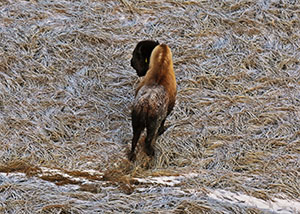
Nearly 99 percent of the bison have stayed within 50 miles of their release point near Shageluk. Wood bison number 124, a young cow, was the exception. She traveled more than 200 miles south of the main herd before she was illegally shot and killed on Jan. 27, 2017, near the village of Quinhagak. Alaska Wildlife Troopers are investigating the incident, and a local man has been charged.
A wanderer that captured the hearts of rural communities across western Alaska, Bison 124 was a young cow known for its extensive exploration of the Yukon, Kuskokwim, and Innoko drainages. Residents of Grayling, Anvik, Shageluk, Holy Cross, Kalskag, Aniak, Russian Mission, Akiachuk, Kwethluk, Tuntutuliak, Eek, and Bethel welcomed the animal and enjoyed watching it explore new habitat.
"This is a sad loss," said Tom Seaton, a state wildlife biologist who oversees the wood bison restoration project. "Many local residents have called to express their disappointment with this restoration setback."
In her travels, she found many areas of good wood bison habitat. She spent the summer of 2015 away from the main herd, ranging south along the Kuskokwim River between Aniak and Kalskag. Then she returned to the main herd near Shageluk in late summer 2015.
In the fall of 2015, she began traveling south again, away from the main herd. She spent the first half of the winter near Russian Mission, then the last half of the winter (early 2016) near Kwethluk. She continued moving south and by August of 2016, she had been sighted by folks near Aniak, Kalskag, Bethel, and Tuntatuliak. In late August of 2016, she was all the way down to the mouth of the Kuskokwim, on Eek Island. During her travels, citizen scientists in these various communities documented her movements, provided pictures, and reported her location as well as other important information like body condition.
She continued moving south. During an aerial survey in November 2016, biologists saw her near Quinhagak on the coast of the Bering Sea. She apparently remained in that area for several months before her death.
While bison 124 was exploring the Bering coast, 98 percent of the herd has remained within 50 miles of their release point near Shageluk. During the last eight months of 2016 there were no known mortalities in the herd, an amazing thing for any group of wild animals. The population is increasing and currently has about 138 individuals. The excellent body condition of these animals suggests that this experimental population is well on its way to succeeding in the wild.
Visit the ADF&G website to learn more about the wood bison reintroduction, and wood bison as a species.
